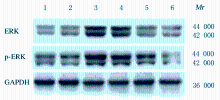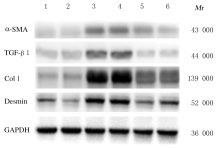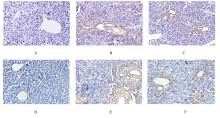| 1 |
AYDIN MM, AKÇALI KC. Liver fibrosis [J]. Turk J Gastroenterol, 2018, 29 (1):14-21.
|
| 2 |
FRIEDRICH-RUST M, WANGER B, HEUPEL F, et al. Influence of antibiotic-regimens on intensive-care unit-mortality and liver-cirrhosis as risk factor [J]. World J Gastroenterol, 2016, 22(16):4201-4210.
|
| 3 |
SEKI E, BRENNER D A. Recent advancement of molecular mechanisms of liver fibrosis [J]. J Hepato-Biliary-Pancreat Sci, 2015, 22(7):512-518.
|
| 4 |
LI J, LI X, XU W, et al. Antifibrotic effects of luteolin on hepatic stellate cells and liver fibrosis by targeting AKT/mTOR/p70S6K and TGFβ/Smad signalling pathways [J]. Liver Int, 2015, 35(4):1222-1233.
|
| 5 |
TSUCHIDA T, FRIEDMAN S L. Mechanisms of hepatic stellate cell activation [J]. Nat Rev Gastroenterol Hepatol, 2017, 14(7):397-411.
|
| 6 |
YANG J H, KIM S C, KIM K M, et al. Isorhamnetin attenuates liver fibrosis by inhibiting TGF-β/Smad signaling and relieving oxidative stress [J]. Eur J Pharmacol, 2016, 783:92-102.
|
| 7 |
SHANY S, SIGAL-BATIKOFF I, LAMPRECHT S. Vitamin D and myofibroblasts in fibrosis and cancer: At cross-purposes with TGF-β/SMAD signaling [J]. Anticancer Res, 2016, 36(12):6225-6234.
|
| 8 |
DURAN A, HERNANDEZ E D, REINA-CAMPOS M, et al. p62/SQSTM1 by binding to vitamin D receptor inhibits hepatic stellate cell activity, fibrosis, and liver cancer [J]. Cancer Cell, 2016, 30(4):595-609.
|
| 9 |
TRIANTOS C, AGGELETOPOULOU I, KALAFATELI M, et al. Prognostic significance of vitamin D receptor (VDR) gene polymorphisms in liver cirrhosis [J]. Sci Rep, 2018, 8(1):14065.
|
| 10 |
MAESTRO M A, MOLNÁR F, CARLBERG C. Vitamin D and its synthetic analogs [J]. J Med Chem, 2019, 62(15):6854-6875.
|
| 11 |
REITER F P, YE L, BOSCH F, et al. Antifibrotic effects of hypocalcemic vitamin D analogs in murine and human hepatic stellate cells and in the CCl4 mouse model [J]. Lab Invest, 2019, 99(12):1906-1917.
|
| 12 |
ZERR P, VOLLATH S, PALUMBO-ZERR K, et al. Vitamin D receptor regulates TGF-β signalling in systemic sclerosis [J].Ann Rheum Dis,2015,74(3):e20.
|
| 13 |
CAI F F, WU R, SONG Y N, et al. Yinchenhao decoction alleviates liver fibrosis by regulating bile acid metabolism and TGF-β/Smad/ERK signalling pathway [J]. Sci Rep, 2018, 8(1):15367.
|
| 14 |
LI X Q, ZHANG H, PAN L J, et al. Puerarin alleviates liver fibrosis via inhibition of the ERK1/2 signaling pathway in thioacetamideinduced hepatic fibrosis in rats [J]. Exp Therapeut Med, 2019, 18(1):133-138.
|
| 15 |
REITER F P, HOHENESTER S, NAGEL J M, et al. 1,25-(OH)2-vitamin D3 prevents activation of hepatic stellate cells in vitro and ameliorates inflammatory liver damage but not fibrosis in the Abcb4(‒/‒) model [J]. Biochem Biophys Res Commun, 2015, 459(2):227-233.
|
| 16 |
CAMPANA L, IREDALE J. Regression of liver fibrosis [J]. Semin Liver Dis, 2017, 37(1):001-010.
|
| 17 |
TAG C G, SAUER-LEHNEN S, WEISKIRCHEN S, et al. Bile duct ligation in mice: induction of inflammatory liver injury and fibrosis by obstructive cholestasis [J]. JoVE, 2015(96):52438.
|
| 18 |
SATO K, MARZIONI M, MENG F, et al. Ductular reaction in liver diseases: pathological mechanisms and translational significances[J].Hepatology,2019,69(1):420-430.
|
| 19 |
SATO K, MENG F Y, GIANG T, et al. Mechanisms of cholangiocyte responses to injury [J]. Biochim Biophys Acta Mol Basis Dis, 2018, 1864:1262-1269.
|
| 20 |
MARADANA M R, YEKOLLU S K, ZENG B, et al. Immunomodulatory liposomes targeting liver macrophages arrest progression of nonalcoholic steatohepatitis [J]. Metab Clin Exp, 2018, 78:80-94.
|
| 21 |
GUO J, MA Z, MA Q, et al. 1, 25(OH)2D3 Inhibits hepatocellular carcinoma development through reducing secretion of inflammatory cytokines from immunocytes[J].Curr Med Chem, 2013, 20(33):4131-4141.
|
| 22 |
CHRISTAKOS S, DHAWAN P, VERSTUYF A, et al. Vitamin D: Metabolism, molecular mechanism of action, and pleiotropic effects [J]. Physiol Rev, 2016, 96(1):365-408.
|
| 23 |
ZHANG J, YANG S, XU B, et al. p62 functions as an oncogene in colorectal cancer through inhibiting apoptosis and promoting cell proliferation by interacting with the vitamin D receptor[J].Cell Prolif,2019,52(3):e12585.
|
| 24 |
ROWE I A. Lessons from epidemiology: The burden of liver disease [J]. Dig Dis, 2017, 35(4):304-309.
|
| 25 |
FABREGAT I, CABALLERO-DÍAZ D. Transforming growth factor-β-induced cell plasticity in liver fibrosis and hepatocarcinogenesis [J]. Front Oncol, 2018, 8:357.
|
| 26 |
RAMIREZ A M, WONGTRAKOOL C, WELCH T, et al. Vitamin D inhibition of pro-fibrotic effects of transforming growth factor β1 in lung fibroblasts and epithelial cells [J]. J Steroid Biochem Mol Biol, 2010, 118(3):142-150.
|
| 27 |
KIM S J, ISE H, GOTO M, et al. Interactions of vimentin-or desmin-expressing liver cells with N-acetylglucosamine-bearing polymers [J]. Biomaterials, 2012, 33(7):2154-2164.
|
| 28 |
WANG Y, DEB D K, ZHANG Z, et al. Vitamin D receptor signaling in podocytes protects against diabetic nephropathy [J]. J Am Soc Nephrol, 2012, 23(12):1977-1986.
|
| 29 |
ROSKOSKI R. ERK1/2 MAP kinases: structure, function, and regulation [J].Pharmacol Res,2012,66(2):105-143.
|
| 30 |
LONG T, WANG L, YANG Y, et al. Protective effects of trans-2,3,5,4′-tetrahydroxystilbene 2-O-β-D-glucopyranoside on liver fibrosis and renal injury induced by CCl4 via down-regulating p-ERK1/2 and p-Smad1/2[J].Food Funct, 2019, 10(8):5115-5123.
|
 )
)














